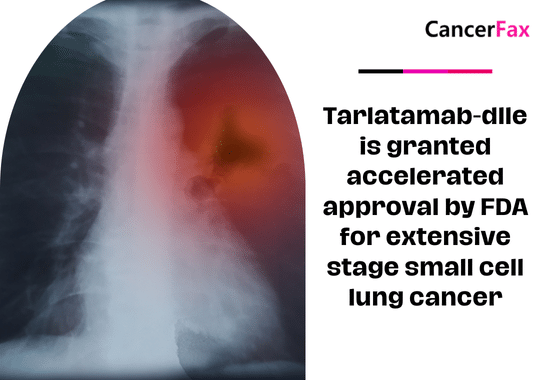Tarlatamab-dlle is granted accelerated approval by FDA for extensive stage small cell lung cancer
May 2024: Tarlatamab-dlle (Imdelltra, Amgen, Inc.) has received fast approval from the Food and Drug Administration for the treatment of extensive stage small cell lung cancer (ES-SCLC) in patients whose illness has worsened after platinum-based chemotherapy.
The effectiveness of the treatment was assessed in a group of 99 patients with relapsed/refractory ES-SCLC who experienced disease progression after receiving platinum-based chemotherapy. These patients were included in DeLLphi-301 [NCT05060016], which is open-label, multicenter, multi-cohort research.
Patients who had symptomatic brain metastases, interstitial lung disease, non-infectious pneumonitis, or active immunodeficiency were not included in the study. Patients were administered tarlatamab until there was evidence of illness progression or the occurrence of intolerable side effects.
The main ways to tell if something worked were the overall response rate (ORR) based on RECIST 1.1 criteria and the duration of response (DOR), which was found by an independent central review that was blinded. The overall response rate (ORR) was 40%, with a 95% confidence interval (CI) ranging from 31% to 51%. The median duration of response (DOR) was 9.7 months, with a range of 2.7 to 20.7+ months.
Out of the 69 patients for whom data on platinum sensitivity status was available, the overall response rate (ORR) was 52% (95% confidence interval [CI] 32, 71) in 27 patients with platinum-resistant small cell lung cancer (SCLC) (defined as progression occurring within 90 days after the last dose of platinum therapy) and 31% (95% CI 18, 47) in 42 patients with platinum-sensitive SCLC (defined as progression occurring 90 days or more after the last dose of platinum therapy).
There is a boxed warning in the tarlatamab-dlle prescribing information about the possibility of severe or life-threatening cytokine release syndrome (CRS) and neurologic damage, specifically immune effector cell-associated neurotoxicity syndrome (ICANS). The predominant side effects (>20%) included cytokine release syndrome (CRS), fatigue, pyrexia, dysgeusia, decreased appetite, musculoskeletal discomfort, constipation, anemia, and nausea.
In at least 5% of cases, lab tests showed Grade 3 or 4 problems, such as fewer lymphocytes, lower sodium levels, higher uric acid levels, fewer total neutrophils, lower hemoglobin levels, longer activated partial thromboplastin time, and lower potassium levels.
The suggested tarlatamab dosage is an initial dose of 1 mg given intravenously over a period of 1 hour on the first day of the first cycle, followed by 10 mg on the 8th and 15th day of the first cycle, and then every 2 weeks thereafter until there is disease progression or intolerable toxicity.
Susan Hau is a distinguished researcher in the field of cancer cell therapy, with a particular focus on T cell-based approaches and cancer vaccines. Her work spans several innovative treatment modalities, including CAR T-cell therapy, TIL (Tumor-Infiltrating Lymphocyte) therapy, and NK (Natural Killer) cell therapy.
Hau's expertise lies in cancer cell biology, where she has made significant contributions to understanding the complex interactions between immune cells and tumors.
Her research aims to enhance the efficacy of immunotherapies by manipulating the tumor microenvironment and exploring novel ways to activate and direct immune responses against cancer cells.
Throughout her career, Hau has collaborated with leading professors and researchers in the field of cancer treatment, both in the United States and China.
These international experiences have broadened her perspective and contributed to her innovative approach to cancer therapy development.
Hau's work is particularly focused on addressing the challenges of treating advanced and metastatic cancers. She has been involved in clinical trials evaluating the safety and efficacy of various immunotherapy approaches, including the promising Gamma Delta T cell therapy.
- Comments Closed
- June 19th, 2024






Accelerated approval 2024, bispecific T-cell engager, DLL3-targeted therapy, Extensive-stage small cell lung cancer, First-in-class DLL3 inhibitor, Imdelltra for SCLC, SCLC immunotherapy, Tarlatamab-dlle approval
CancerFax is the most trusted online platform dedicated to connecting individuals facing advanced-stage cancer with groundbreaking cell therapies.
Send your medical reports and get a free analysis.
🌟 Join us in the fight against cancer! 🌟
Привет,
CancerFax — это самая надежная онлайн-платформа, призванная предоставить людям, столкнувшимся с раком на поздних стадиях, доступ к революционным клеточным методам лечения.
Отправьте свои медицинские заключения и получите бесплатный анализ.
🌟 Присоединяйтесь к нам в борьбе с раком! 🌟